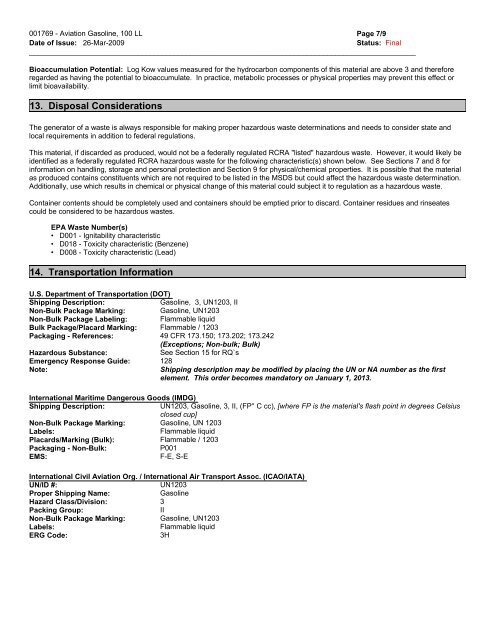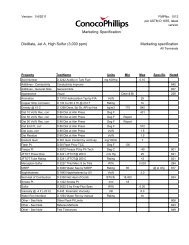COP Fuels Tests DH - Phillips 66 Aviation
COP Fuels Tests DH - Phillips 66 Aviation
COP Fuels Tests DH - Phillips 66 Aviation
Create successful ePaper yourself
Turn your PDF publications into a flip-book with our unique Google optimized e-Paper software.
001769 - <strong>Aviation</strong> Gasoline, 100 LL<br />
Date of Issue: 26-Mar-2009<br />
________________________________________________________________________________________________<br />
Bioaccumulation Potential: Log Kow values measured for the hydrocarbon components of this material are above 3 and therefore<br />
regarded as having the potential to bioaccumulate. In practice, metabolic processes or physical properties may prevent this effect or<br />
limit bioavailability.<br />
13. Disposal Considerations<br />
The generator of a waste is always responsible for making proper hazardous waste determinations and needs to consider state and<br />
local requirements in addition to federal regulations.<br />
This material, if discarded as produced, would not be a federally regulated RCRA "listed" hazardous waste. However, it would likely be<br />
identified as a federally regulated RCRA hazardous waste for the following characteristic(s) shown below. See Sections 7 and 8 for<br />
information on handling, storage and personal protection and Section 9 for physical/chemical properties. It is possible that the material<br />
as produced contains constituents which are not required to be listed in the MSDS but could affect the hazardous waste determination.<br />
Additionally, use which results in chemical or physical change of this material could subject it to regulation as a hazardous waste.<br />
Container contents should be completely used and containers should be emptied prior to discard. Container residues and rinseates<br />
could be considered to be hazardous wastes.<br />
EPA Waste Number(s)<br />
• D001 - Ignitability characteristic<br />
• D018 - Toxicity characteristic (Benzene)<br />
• D008 - Toxicity characteristic (Lead)<br />
14. Transportation Information<br />
U.S. Department of Transportation (DOT)<br />
Shipping Description: Gasoline, 3, UN1203, II<br />
Non-Bulk Package Marking: Gasoline, UN1203<br />
Non-Bulk Package Labeling: Flammable liquid<br />
Bulk Package/Placard Marking: Flammable / 1203<br />
Packaging - References: 49 CFR 173.150; 173.202; 173.242<br />
(Exceptions; Non-bulk; Bulk)<br />
Hazardous Substance: See Section 15 for RQ`s<br />
Emergency Response Guide: 128<br />
Note: Shipping description may be modified by placing the UN or NA number as the first<br />
element. This order becomes mandatory on January 1, 2013.<br />
International Maritime Dangerous Goods (IMDG)<br />
Shipping Description: UN1203, Gasoline, 3, II, (FP° C cc), [where FP is the material's flash point in degrees Celsius<br />
closed cup]<br />
Non-Bulk Package Marking: Gasoline, UN 1203<br />
Labels: Flammable liquid<br />
Placards/Marking (Bulk): Flammable / 1203<br />
Packaging - Non-Bulk: P001<br />
EMS: F-E, S-E<br />
International Civil <strong>Aviation</strong> Org. / International Air Transport Assoc. (ICAO/IATA)<br />
UN/ID #: UN1203<br />
Proper Shipping Name: Gasoline<br />
Hazard Class/Division: 3<br />
Packing Group: II<br />
Non-Bulk Package Marking: Gasoline, UN1203<br />
Labels: Flammable liquid<br />
ERG Code: 3H<br />
Page 7/9<br />
Status: Final




